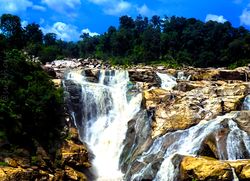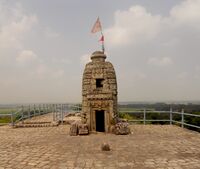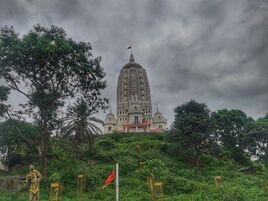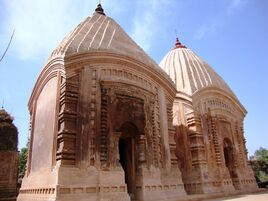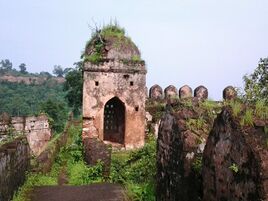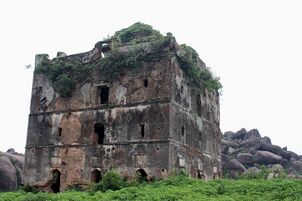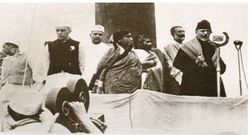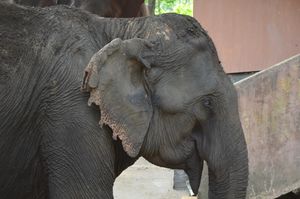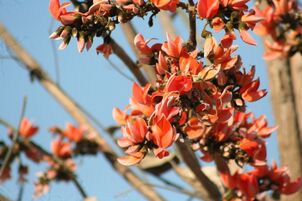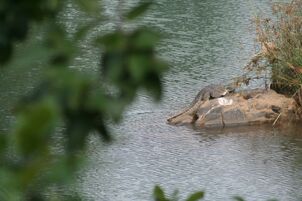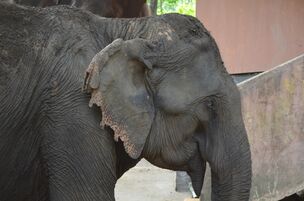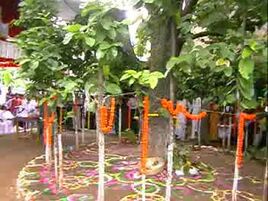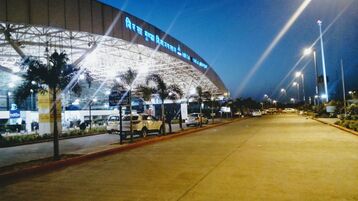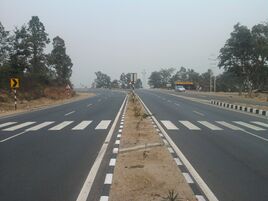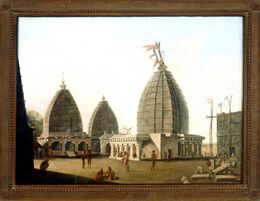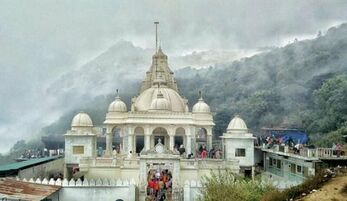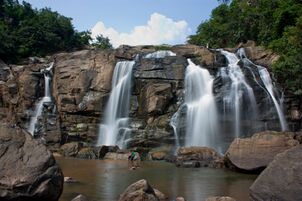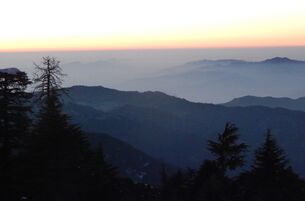جهارخند
Jharkhand | |||||||||||||||||||||||
|---|---|---|---|---|---|---|---|---|---|---|---|---|---|---|---|---|---|---|---|---|---|---|---|
[[States and union territories of India|ولاية]] | |||||||||||||||||||||||
Clockwise from top: Dassam Falls, Birla Institute of Technology, Panchet Dam at Damodar river, Samet Shikharji Jain Mahatirth, Baidyanath Temple, Patratu Highway and Dalma Wildlife Sanctuary | |||||||||||||||||||||||
| أصل الاسم: "أرض الغابة" | |||||||||||||||||||||||
| الكنية: "أرض الغابات" | |||||||||||||||||||||||
| الشعار: Satyameva Jayate (الحق وحده ينتصر) | |||||||||||||||||||||||
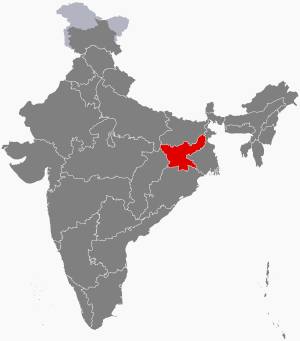 Location of Jharkhand in India | |||||||||||||||||||||||
| الإحداثيات: 23°21′N 85°20′E / 23.35°N 85.33°E | |||||||||||||||||||||||
| Country | |||||||||||||||||||||||
| Region | الهند الشرقية | ||||||||||||||||||||||
| Before was | جزء من بيهار | ||||||||||||||||||||||
| As State | التأسيس | ||||||||||||||||||||||
| Capital | رانچي | ||||||||||||||||||||||
| Largest City | [[جمشيدپور]] | ||||||||||||||||||||||
| المساحة | |||||||||||||||||||||||
| • الإجمالي | 79٫714 كم² (30٫778 ميل²) | ||||||||||||||||||||||
| ترتيب المساحة | [[List of states and union territories of India by area|16]] | ||||||||||||||||||||||
| التعداد (2011)[1] | |||||||||||||||||||||||
| • الإجمالي | 32٫988٫134 | ||||||||||||||||||||||
| • الترتيب | [[List of states and union territories of India by population|14]] | ||||||||||||||||||||||
| GDP | |||||||||||||||||||||||
| • Total (2023–24) | ▲₹4٫23 lakh crore (53 بليون US$) | ||||||||||||||||||||||
| • Rank | 19th | ||||||||||||||||||||||
| • Per capita | |||||||||||||||||||||||
| منطقة التوقيت | UTC+05:30 (IST) | ||||||||||||||||||||||
| ISO 3166 code | IN-JH | ||||||||||||||||||||||
| Vehicle registration | JH | ||||||||||||||||||||||
| HDI (2022) | |||||||||||||||||||||||
| Literacy (2011) | ▲ 66.41% (32nd) | ||||||||||||||||||||||
| Sex ratio (2021) | 948♀/1000 ♂[2] (26th) | ||||||||||||||||||||||
| الموقع الإلكتروني | jharkhand | ||||||||||||||||||||||
| |||||||||||||||||||||||
| [2]تشكلت بموجب قرار اعادة تنظيم بيهار لسنة 2000 | |||||||||||||||||||||||
جهارخند ( Jharkhand ؛ (/ˈdʒɑːrkənd/؛[6] هندوستاني: [d͡ʒʱɑːɾkʰəɳɖ]؛حرفياً "أرض الغابات")، هي ولاية في شرق الهند،[7] اقتطعت من الجزء الجنوبي من بيهار في 15 نوفمبر 2000.[8] تتشارك الولاية حدودها مع ولايات بيهار من الشمال، اوتار پرادش من الشمال الغربي، چهاتيسگره من الغرب، أوديشا من الجنوب، والبنغال الغربية من الشرق. تبلغ مساحتها 30.778 كم².
عاصمتها مدينة رانچي وعاصمتها الفرعية دومكا. The state is known for its waterfalls, hills and holy places; Baidyanath Dham, Parasnath, Dewri and Rajrappa are major religious sites.[9][10]
تعاني جهارخند من لعنة الموارد؛[11] وتمتلك أكثر من 40% من الموارد المعدنية في الهند،[12] لكنها تعاني من فقر واسع النطاق حيث يقع 39.1% من سكانها تحت خط الفقر و19.6% من الأطفال تحت الخامسة يعانون من سوء التغذية.[13] تعتبر جهارخند من الولايات الريفية حيث يقيم 24% فقط من سكانها في المدن.[14]
أصل الاسم
The word "Jhar" means 'forest' and "Khand" means 'land' in various Indo-Aryan languages. Thus "Jharkhand" means forest land.[15]
In the ancient period, in the Mahabharata, the region was referred as Kark Khand due to location near Kark Rekha, that is, Tropic of Cancer.[16]قالب:Verify inline During the Medieval period, the region was known as Jharkhand. According to Bhavishya Purana (1200 CE), Jharkhand was one of the seven Pundra desa. The name is first found on a 13th-century copper plate in Kendrapada, Odisha region from the reign of Narasimha Deva II of Eastern Ganga dynasty. Forest land from Baidhnath dham to Puri was known as Jharkhand. In Akbarnama, from Panchet in the east to Ratanpur to west, Rohtasgarh to the north and the frontier of Odisha to the south was known as Jharkhand.[17][18]
التاريخ
العصر القديم
The region has been inhabited since the Mesolithic-Chalcolithic period, as shown by several ancient cave paintings.[19][20][21] Stone tools have been discovered from Chota Nagpur plateau region which are from the Mesolithic and Neolithic periods.[19] There are ancient cave paintings in Isko, Hazaribagh district which are from Meso-chalcolithic period (9000–5000 BCE).[20] During 2nd millennium BCE the use of Copper tools spread in Chota Nagpur Plateau and these find complexes are known as the Copper Hoard Culture.[22] In the Kabra-Kala mound at the confluence of the Son and North Koel rivers in Palamu district various antiquities and art objects have been found which are from the Neolithic to the medieval period and pot-sherds of Redware, black and red ware, black ware, black slipped ware and NBP ware are from Chalcolithic to the late medieval period.[23] Several iron slags, microliths, and potsherds have been discovered from Singhbhum district that are from 1400 BCE according to carbon dating age.[21] The region was ruled by many empires and dynasties including Nanda, Maurya and Gupta during ancient period.
In the Mahabharata, the region was referred as Kark Khand due to its location near Tropic of Cancer.[16] During the age of Mahajanpadas around 500 BCE, Jharkhand state was a part of Magadha and Anga.[24][بحاجة لمصدر] In the Mauryan period, this region was ruled by a number of states, which were collectively known as the Atavika (forest) states. These states were subdued and were forced to accept the hegemony of the Maurya empire during Ashoka's reign (c. 232 BCE). In the ancient site of Saridkel, burnt brick houses, red ware pottery, copper tools, coins and iron tools have been found which belong to the early centuries CE.[25] Brahmi inscriptions have been found in Khunti district which are from the 3rd century BCE.[26] Samudragupta, while marching through the present-day Chotanagpur region (North and South), directed the first attack against the kingdom of Dakshina Kosala in the Mahanadi valley.[27]
العصر الوسيط
In the 7th century, the Chinese traveller Xuanzang passed through the region. He described the kingdom as Karnasuvarna, with Shashanka as its ruler. To the north of Karn-Suberna was Magadha, Champa was in the east, Mahendra in the west, and Orissa in the south.[28]
During the medieval period, the region was governed by Nagvanshi, Pala, Khayaravala, Ramgarh Raj and Chero rulers.[29][30] A Buddhist monastery has been found in Hazaribagh which was built during the Pala period in the 10th century.[31] Bhim Karn was a Nagvanshi king during medieval period. He defeated the Raksel dynasty of Surguja when they invaded the region with cavalry.[32]
العصر الحديث
Mughal influence reached Palamu during the reign of Emperor Akbar when it was conquered by Rajput Raja Mansingh in 1574. Several invasions took place during Mughal rule.[33] During the reign of the Nagvanshi King Madhu Singh, Akbar's general invaded Khukhra. Also there was an invasion during the reign of Durjan Shah.[34]
King Ram Shah ruled Navratangarh from 1640 to 1663. He built the Kapilnath Temple in 1643. He was succeeded by his son Raghunath Shah. Thakur Ani Nath Shahdeo built the Jagannath temple of Ranchi in 1691.[35] The King Medini Ray ruled from 1658 to 1674 in Palamu.[36] His rule extended to areas in South Gaya and Hazaribagh. He attacked Navratangarh and defeated the Nagvanshi Maharaja of Chhotanagpur.[37] Chero rule in the Palamu region lasted until the 19th century until internal conflict between various factions weakened the Cheros and they were defeated by the East India Company. Later Palamu estates were sold by the British.[38]
Jagannath temple at Ranchi built by king Ani Nath Shahdeo
During the 18th century, regions under the Kings of the Chero dynasty, Nagvanshi dynasty, Ramgarh and Kharagdiha became parts of territories of East India Company. Ramgarh Raj along with estates of other chiefs in the regions were permanently settled as Zamindari estates. The Kharagdiha Rajas were settled as Rajas of Raj Dhanwar in 1809, and the Kharagdiha gadis were separately settled as zamindari estates. Some of the notable Kharagdiha Zamindari estates were Koderma, Gadi Palganj and Ledo Gadi.[39] The princely states in the Chota Nagpur Plateau came within the sphere of influence of the Maratha Empire, but they became tributary states of British East India Company as a result of the Anglo-Maratha Wars and became known as Chota Nagpur Tributary States.[40]
Subjugation, colonization and imposition of taxes by the British East India Company resulted in spontaneous resistance from the local people. Chuar Rebellion, the first revolt against the British East India Company led by Jagannath Singh Patar in 1767 with the Bhumij tribals. The Bhumijes again revolted in 1769–71, led by their Sardar Ghatwals in Dhalbhum. In 1769, Raghunath Mahato also revolted against the British East India Company (EIC).[41]
In 1771, the revolt against the landlords and the British government was led by Tilka Majhi, a Paharia leader in Rajmahal Hills. Soon after in 1779, the Bhumij tribes again rose in arms against the British rule in Manbhum, called the Chuar Rebellion. In 1807, the Oraons in Barway murdered their landlord from Srinagar. The Munda tribe rose in revolt in 1811 and 1813. Bakhtar Say and Mundal Singh, two landowners, fought against the British East India Company in 1812.[42]
The Hos in Singhbhum revolted in 1820 and a Kol revolt occurred in 1832. Also in 1832 the Bhumijs revolted again against the British, this time under the leadership of Ganga Narayan Singh, known as the Bhumij Rebellion. During the 19th century, large numbers of santals from Manbhum, Hazaribagh, Midnapore were settled by British in Damin-i-koh to cultivate the land and generate revenue. But the Santal revolted against tax imposition. The Santhal rebellion broke out in 1855 under the leadership of two brothers Sidhu and Kanhu. Later the British renamed it as Santal Pargana.[43]
Thakur Vishwanath Shahdeo and Pandey Ganpat Rai rebelled against the British East India Company in the 1857 rebellion. In the Battle of Chatra, conflict took place between the rebels and the East India company.[44][45] Tikait Umrao Singh, Sheikh Bhikhari, Nadir Ali and Jai Mangal Singh played pivotal role in the Indian Rebellion of 1857.[46] The brothers Nilambar and Pitambar were chiefs of Bhogta clan of the Kharwar tribe who held ancestral jagirs with many Chero Jagirdars and led revolt against the British East India company.[33]
After the Indian Rebellion of 1857, the rule of the British East India Company was transferred to the Crown in the person of Queen Victoria,[47] who, in 1876, was proclaimed Empress of India. The Cheros and Kharwars again rebelled against the British in 1882 but the attack was repulsed.[48] Then Birsa Munda revolt,[49] broke out in 1895 and lasted until 1900. The revolt though mainly concentrated in the Munda belt of Khunti, Tamar, Sarwada and Bandgaon.
In October 1905, the exercise of British influence over the predominantly Hindi-speaking states of Chang Bhakar, Jashpur, Koriya, Surguja, and Udaipur was transferred from the Bengal government to that of the Central Provinces, while the two Oriya-speaking states of Gangpur and Bonai were attached to the Orissa Tributary States, leaving only Kharsawan and Saraikela answerable to the Bengal governor.[50]
In 1936, all nine states were transferred to the Eastern States Agency, the officials of which came under the direct authority of the Governor-General of India, rather than under that of any provinces.
In March 1940, the INC 53rd Session[51][52] occurred under the presidency of Maulana Abul Qalam Azad at Jhanda Chowk, Ramgarh now Ramgarh Cantonment. Mahatma Gandhi,[53] Jawaharlal Nehru, Sardar Patel, Rajendra Prasad, Sarojini Naidu, Khan Abdul Ghaffar Khan, Acharya J.B. Kripalani, Industrialist Jamnalal Bajaj and other great leaders[54] of the Indian freedom movement attended the Ramgarh Session.[55] Mahatma Gandhi also opened the khadi and village Industries Exhibition at Ramgarh.[56]
At that time, under the leadership of Netajee Subhas Chandra Bose a conference against Samjhauta was also completed. In Ramgarh, Subhas Chandra Bose was seen as president of the All India Forward Block and M. N. Roy was seen as leader of the Radical democratic party.
ما بعد الاستقلال
After Indian independence in 1947, the rulers of many states chose to accede to the Dominion of India. Changbhakar, Jashpur, Koriya, Surguja and Udaipur later became part of the state of Madhya Pradesh, but Gangpur and Bonai became part of the state of Orissa and Kharsawan and Saraikela became part of the state of Bihar.[57] In 1928, a separate state was demanded by Unnati Samaj, the political wing of the Christian Tribals Association, which submitted a memorandum to the Simon Commission to constitute a tribal state in eastern India.[17] Prominent leaders like Jaipal Singh Munda and Ram Narayan Singh also demanded a separate state. In 1955, the Jharkhand Party, led by Jaipal Singh Munda, submitted a memorandum to the States Reorganization Commission for a separate Jharkhand state comprising the tribal area of South Bihar, but it was rejected because there were many languages, no link language in the region, tribals were in the minority, Hindustani was the majority language, and it risked adverse effect on the economy of Bihar.[58][59]
Later the Sadan people, the native various caste/non-tribal groups, also joined the movement for a separate state.[58] In 1972, Binod Bihari Mahato, Shibu Soren and A. K. Roy founded Jharkhand Mukti Morcha. Nirmal Mahto founded the All Jharkhand Students Union. They led the movement for a separate state of Jharkhand. The Jharkhand coordination committee (JCC), consisting of Ram Dayal Munda, B. P. Keshri, Binod Bihari Mahato, Santosh Rana and Suraj Singh Besra started a new initiative and tried to coordinate between different parties. Keshri sent a memorandum to form Jharkhand state in 1988.[60] The Jharkhand co-ordination committee was then led by Congress General Secretary Ram Ratan Ram, who urged Rajiv Gandhi to pay attention to the issue at hand.
In July 1988, the Bharatiya Janata party led by Atal Bihari Vajpayee, Lal Krishna Advani, and Murli Manohar Joshi decided to demand a separate state, Vanachal, comprising the forest region of South Bihar in Jamshedpur. Inder Singh Namdhari, Samresh Singh, and Rudra Pratap Sarangi were the leaders of the Vanachal movement. They organised several rallies to form a separate state.[61]
The central government formed a committee on the Jharkhand matter in 1989. It stressed the need for greater allocation of development funds for the area. There was a provision for limited internal autonomy in the hill area of Assam. Other tribal areas were covered by the fifth schedule of the constitution. Chotanagpur and Santal Pargana development boards were constituted under the chairmanship of the then chief minister of Bihar under the provision of the fifth schedule in 1972. This failed to achieve the desired result. Jharkhand Mukti Morcha wanted more representation and the All Jharkhand Students Union was against it. Due to differences these parties broke away from each other. The All Jharkhand Students Union introduced elements of violence in the movement and called for a boycott of election while Jharkhand Mukti Morcha opposed this. The Jharkhand Area Autonomous Council bill passed in Bihar's legislative assembly in December 1994. The Jharkhand Area Autonomous Council were given responsibility for forty areas including agriculture, rural health, public work, public health and minerals. The council has power to recommend legislation to the Assembly through the state government and to frame bylaws and regulations.[30][58]
In 1998, when the separate state movement was falling apart, Justice Lal Pingley Nath Shahdeo was leading the movement. In 1998, the Union government decided to send the bill concerning the formation of the state of Jharkhand to the Bihar Legislative Assembly to which Lalu Prasad Yadav had said that the state would be divided over his dead body. A total of 16 political parties including the Bharatiya Janata Party, Jharkhand Mukti Morcha, the All Jharkhand Students Union, and the Congress came in one platform and formed the 'All Party Separate State Formation Committee' to start the movement. Shahdeo was elected as the convener of the committee. Voting on the Jharkhand Act was to be done on 21 September 1998 in Bihar legislation. On that day the committee, under the leadership of Shahdeo called for Jharkhand Bandh and organized a protest march. Thousands of supporters of a separate state took to the streets led by Shahdeo. He was arrested and detained in a police station for hours along with many supporters.[62][63]
In 1999 the Bharatiya Janata party promised to form a separate Vanachal state if they won the state election with a majority of votes.[61] After the last Assembly election in the state resulted in a hung assembly, RJD's dependence on the Congress extended support on the precondition that RJD would not pose a hurdle to the passage of the Bihar reorganisation Bill. Finally, with the support from both RJD and Congress, the ruling coalition at the Centre led by the Bharatiya Janata Party which had made statehood its main poll plank in the region in successive polls earlier, cleared the Bihar reorganisation Bill in the monsoon session of the Parliament on 2 and 11 August in Loksabha and Rajyasabha. This paved the way for the creation of a separate Vanachal state comprising the Chota Nagpur Division and Santhal Pargana Division of South Bihar.[64] NDA formed the government with Babulal Marandi as chief minister. Later the name of the state was changed from Vanachal to Jharkhand.[61][65] Babulal Marandi took the oath of chief minister on 15 November 2000 on the anniversary of the birth of tribal leader Birsa Munda.[30]
تأسيسها كولاية
The dynamics of resources and the politics of development still influence the socio-economic structures in Jharkhand, which was carved out of the relatively underdeveloped southern part of Bihar. According to the 1991 census, the state has a population of over 20 million out of which 28% is tribal while 12% of the people belong to scheduled castes. Jharkhand has 24 districts, 260 blocks, and 32,620 villages out of which only 45% have access to electricity while only 8,484 are connected by roads. Jharkhand is the leading producer of mineral wealth in the country after Chhattisgarh state, endowed as it is with a vast variety of minerals like iron ore, coal, copper ore, mica, bauxite, graphite, limestone, and uranium. Jharkhand is also known for its vast forest resources.[66]
تمرد ناكسال
Jharkhand has been at the centre of the Naxalite-Maoist insurgency. Since the uprising of the Naxalites in 1967, 6,000 people have been killed in fighting between the Naxalites and counter-insurgency operations by the police, and its paramilitary groups such as the Salwa Judum.[67]
Despite having a presence in almost 7.80% of India's geographical area[68] (home to 5.50% of India's population), the state of Jharkhand is part of the "Red Corridor" comprising 92,000 square kilometres,[68] where the highest concentration of the groups estimated 20,000 combatants fight.[69] Part of this is due to the fact that the state harbours an abundance of natural resources, while its people live in abject poverty and destitution.[70] The impoverished state provides ample recruits for communist insurgents, who argue that they are fighting on behalf of the landless poor and tribals that see few benefits from the resource extractions.[70] As the federal government holds a monopoly on sub-surface resources in the state, the tribal population is prevented from staking any claim on the resources extracted from their land.[70] In response, the insurgents have recently begun a campaign of targeting infrastructure related to the extraction of resources vital for Indian energy needs, such as coal.[68]
On 5 March 2007, Sunil Mahato, a member of the national parliament, was shot dead by Naxalite rebels near Kishanpur while watching a football match on the Hindu festival of Holi. His widow, Suman Mahato, the Jharkhand Mukti Morcha candidate, won the Jamshedpur Lok Sabha by-election in September 2007 and served in parliament until 2009.[71]
الجغرافيا
| يوم التأسيس | 15 نوفمبر 2000 بموجب "قانون اعادة تنظيم بيهار، 2000" | |
| حيوان الولاية | الفيل[3] | |
| طائر الولاية | Koel | 
|
| شجرة الولاية | الشورية[3] | |
| زهرة الولاية | Palash[3] |

Jharkhand is located in the eastern part of India and is enclosed by West Bengal to the eastern side, Chhattisgarh and Uttar Pradesh to the western side, Bihar to the northern part and Odisha to the southern part.
Jharkhand envelops a geographical area of 79،716 متر كيلومربع (30،779 sq mi). Much of Jharkhand lies on the Chota Nagpur Plateau. Many rivers pass through the Chota Nagpur plateau. They are: Damodar, North Koel, Barakar, South Koel, Sankh and Subarnarekha rivers. The higher watersheds of these rivers stretch out within the Jharkhand state. Much of the Jharkhand state is still enclosed by forest. Forests sustain the population of elephants and tigers.
المناخ
Climate of Jharkhand varies from Humid subtropical in the north to tropical wet and dry in the south-east.[72] The main seasons are summer, rainy, autumn, winter and spring. The summer lasts from mid-April to mid-June. May, the hottest month, characterised by daily high temperatures around 37 °C (99 °F) and low temperatures around 25 °C (77 °F). The southwest monsoon, from mid-June to October, brings nearly all the state's annual rainfall, which ranges from about 1،000 mm (40 in) in the west-central part of the state to more than 1،500 mm (60 in) in the southwest. Nearly half of the annual precipitation falls in July and August. The winter season lasts from November to February. The temperatures in Ranchi in December usually vary from 10–24 °C (50–75 °F). Spring season lasts from mid-February to mid-April.[73]
التلال والسلاسل الجبلية
- Parasnath: Parasnath Hill is also called as Sri Sammed Sikharji by Jains. The Parasnath Hill is situated in Giridih district of Jharkhand. It is a chief Jain pilgrimage site and the holy place for Jains and locals. It is believed in the Jain culture that 20 of the 24 Tirthankaras attained Moksha from this place. The height of the hill is 1,365 meters.
- Netarhat: Netarhat is a town in Latehar district. Referred to as the "Queen of Chotanagpur", it is a hill station. Netarhat Residential School is located here. Netarhat Dam is also located in this area.
- Rajmahal Hills: These hills are located in Sahibganj and Godda districts of Eastern part of Jharkhand. The Rajmahal hills belong to the Jurassic era. These hills like others also have many waterfalls, lakes and greenery.
- Trikut: Trikut Hill is located ten kilometres away from Deoghar and lies on the way to Dumka in Jharkhand. Trikut hill is also called Trikutchal because there are 3 major peaks on the hill. The height of Trikut hill is 2470 feet.
- Tagore Hill: The Tagore Hill is also recognised as the Morabadi Hill. The Tagore hill is located in Morabadi, Ranchi. The brother of Rabindranath Tagore, Jyotirindranath Tagore had made a tour at Ranchi in the year 1908.[74]
الأنهار الرئيسية
- Ganga River: The holy river Ganga passes through the north-eastern district of Sahebganj. Cities on the banks of Ganga river in Jharkhand: Sahebganj, Rajmahal
- Son River: Origin of Son River: Amarkantak, Cities on the Shore of Son River: Sidhi
- Subarnarekha River: Origin of Subarnarekha River: (Nagdi Ranchi) Chota Nagpur Plateau, Cities on the Shore of Subarnarekha River: Ranchi, Chandil, Jamshedpur, Ghatshila, Gopiballavpur
- Kharkai River: Origin of Kharkai River: Mayurbhanj District, Odisha; Cities on the Shore of Kharkai River: Rairangpur, Adityapur, and enters the Subarnarekha river in north-western Jamshedpur.
- Damodar River: Origin of Damodar River: Chota Nagpur Plateau (Tori latehar), Cities on the Shore of Damodar River: latehar, lohardaga, Ramgarh, Gridih, Dhanbad, Bokaro, Asansol, Raniganj, Durgapur, Bardhaman
- North Koel River: Origin of North Koel River: Chota Nagpur plateau, Cities on Shore of North Koel River: Daltonganj
- South Koel River: Origin of South Koyal River: Chota Nagpur Plateau (Nagdi Ranchi), Cities on the Shore of South Koyal River: Manoharpur, Rourkela
- Lilajan River: Also known as Falgu river. Origin of Lilajan River: Northern Chota Nagpur Plateau, City on the Shore: Gaya
- Ajay River: Origin of Ajay River: Munger, Cities on the Shore of Ajay River: Purulia, Chittaranjan, Ilambazar, Jaydev Kenduli
- Mayurakshi River: Origin of Mayurakshi River: Trikut hill, City on the Shore of Mayurakshi River: Suri
- Barakar River: Origin: Padma in Hazaribagh, Barakar Nadi flows through the districts of Koderma, Giridih, Hazaribagh, etc.
For the list of dams built across these revere refer to [3]
النبيت والوحيش
Jharkhand has a rich variety of flora and fauna. The national parks and the zoological gardens in the state of Jharkhand present a panorama of this variety.
Part of the reason for the variety and diversity of flora and fauna found in Jharkhand state may be accredited to the Palamau Tiger Reserves under the Project Tiger. This reserve is abode to hundreds of species of flora and fauna,[75] as indicated within brackets: mammals (39), snakes (8), lizards (4), fish (6), insects (21), birds (170), seed bearing plants and trees (97), shrubs and herbs (46), climbers, parasites and semi-parasites (25), and grasses and bamboos (17).
Palash flowers, bright red, pepper the skyline in Jharkhand during fall, also known as forest fire
A Female Indian Elephant at Dalma Wildlife Sanctuary in Jharkhand
السكان
| السنة | تعداد | ±% |
|---|---|---|
| 1901 | 6٬068٬233 | — |
| 1911 | 6٬747٬122 | +11.2% |
| 1921 | 6٬767٬770 | +0.3% |
| 1931 | 7٬908٬737 | +16.9% |
| 1941 | 8٬868٬069 | +12.1% |
| 1951 | 9٬697٬254 | +9.4% |
| 1961 | 11٬606٬489 | +19.7% |
| 1971 | 14٬227٬133 | +22.6% |
| 1981 | 17٬612٬069 | +23.8% |
| 1991 | 21٬844٬911 | +24.0% |
| 2001 | 26٬945٬829 | +23.4% |
| 2011 | 32٬988٬134 | +22.4% |
| Source: Census of India[76] | ||
According to the 2011 Indian Census, Jharkhand has a population of 32.96 million, consisting of 16.93 million males and 16.03 million females.[77] The sex ratio is 947 females to 1,000 males.[77] The literacy rate of the state was 67.63% with Ranchi district being most educated at 77.13% compared to rural Pakur district being least at 50.17%.[77] In social demographics, Jharkhand's Scheduled Caste and Scheduled Tribes populations are 3,985,644 (12.08%) and 8,646,189 (26.21%), respectively. Nationally, they rank 14th and 6th, comprising 1.98% and 8.29% of the total population within these social groups. They are predominantly concentrated in south-western district Simdega (78.23%), Khunti (77.77%), Gumla (72.11%), Paschim Singhbhum (71.1%), Latehar (66.85%), and in Lohardaga district (60.21%).
Languages
Jharkhand is linguistically diverse, with speakers of Indo-Aryan, Dravidian, and Austroasiatic languages. Among those, Hindi is accorded the status of the official language and is spoken as the link language by the people of the state,[79] although different regional languages exist. Those include Nagpuri, Khortha, Kurmali, Magahi and Bhojpuri. Jharkhand has accorded additional official language status to Angika, Bengali, Bhojpuri, Bhumij, Ho, Kharia, Kurukh, Khortha, Kurmali, Magahi, Maithili, Mundari, Nagpuri, Odia, Santali and Urdu.[80][81][79]
Religion

Religion in Jharkhand (2011)[82]
As per the 2011 census, Hinduism is the majority religion in the state at 67.8%, followed by Islam at 14.5% and Christianity at 4.3%.[82] Other religions, primarily Sarnaism, claim to be 12.8% of the population.[83]
Hindus form majority in 19 out of 24 districts of the Jharkhand. Christianity forms majority in Simdega district (51.04%).[84] Sarna forms majority in Lohardaga (51.01%), West Singhbhum (62.29%) and plurality in Gumla (44.62%) and Khunti (45.37%).[85] Muslims have highest presence in Pakur district and Sahebganj district of Jharkhand forming 35% and 34% of the population.[86]
المطبخ
التقسيمات الادارية
الأقسام والأضلاع
المدن الرئيسية
| المدن الكبرى في جهارخند (تقديرات تعداد سكان الهند 2011)[87] | |||||||||||
|---|---|---|---|---|---|---|---|---|---|---|---|
| الترتيب | المدينة | الضلع | السكان | الترتيب | المدينة | الضلع | السكان | ||||
| 01 | جمشيدپور | سينگبوم الشرقية | 1,339,438 | 06 | پوسرو | بوكارو | 185,555 | ||||
| 02 | دانباد | دانباد | 1,196,214 | 07 | هزاريباگ | هزاريباگ | 153,595 | ||||
| 03 | رانچي | رانچي | 1,120,374 | 08 | گيريدي | گيريدي | 143,630 | ||||
| 04 | مدينة بوكارو ستيل | بوكارو | 564,319 | 09 | رامگار | رامگار | 132,425 | ||||
| 05 | ديوگار | ديوگار | 203,123 | 10 | دالتونگاني | پالامو | 120,325 | ||||
الاقتصاد
The gross domestic product of Jharkhand is estimated at ₹3٫83 lakh crore (48 بليون US$) in 2020–21. The per capita GDP of Jharkhand in 2018-19 was ₹82٬430 (US$1٬000).[88]
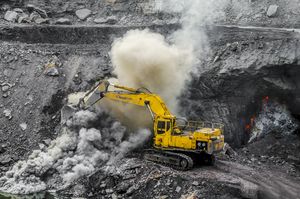
Jharkhand has several towns and innumerable villages with civic amenities. Urbanization ratio is 24.1%.[89] Jharkhand also has immense mineral resources: minerals ranging from (ranking in the country within bracket) from iron ore (4th), coal (3rd), copper ore (1st), mica (1st), bauxite (3rd), manganese, limestone, china clay, fire clay, graphite (8th), kainite (1st), chromite (2nd), asbestos (1st), thorium (3rd), sillimanite, uranium (Jaduguda mines, Narwa Pahar) (1st) and even gold (Rakha Mines) (6th) and silver and several other minerals. Large deposits of coal and iron ore support concentration of industry, in centres like Jamshedpur, Dhanbad, Bokaro and Ranchi. Tata Steel, a NSE NIFTY 500 conglomerate has its corporate office and main plant in Tatanagar, Jharkhand.[90] It reported a gross income of ₹. 204,910 million for 2005. NTPC will start coal production from its captive mine in state in 2011–12, for which the company will be investing about Rs 18 billion.[91]
Agriculture is another sector in the economy of Jharkhand which helps the economy to grow. In Jharkhand, farmers produce several crops such as rice, wheat, maize, pulses, potatoes, and vegetables such as tomato, carrots, cabbage, brinjal, pumpkin, and papaya. The other Industries are cottage industry and IT industry.[92]
Culture
Cuisine
Staple foods of Jharkhand are rice, dal, vegetables, and tubers. Spices are sparingly used in cuisine. Famous dishes include Chhilka Roti, Malpua, Pitha, Dhooska, Arsa roti, Dudhauri, and Panipuri (Gupchup).[93][94] Rugra and Putoo is a type of edible mushroom that is grown extensively in Jharkhand and harvested during the rainy months. It has a hardened, white, edible shell and a softer dark colored centre. Bamboo shoots are also used as a vegetable.[95] The leaves of Munga (Moringa oleifera) and Koinar (Bauhinia variegata) trees are used as a leafy vegetable or Saag.[96]
Local alcoholic drinks include rice beer, originally known as Handi or Handia, named after the vessel, handi (earthen pot), used to make it. Handia is culturally associated with natives, i.e., Sadans and Tribals; this drink is consumed by both men and women on social occasions like marriage and festivals.[97][98] Another common liquor is called Mahua daru, made from flowers of the Mahua tree (Madhuca longifolia).[99]
Folk music and dance
There are several folk dances in Jharkhand such as: Jhumair, Mardani Jhumar, Janani Jhumar, Domkach, Vinsariya, Jhumta, Fagua, Angnai, Paiki, Chhau, Firkal, Mundari, and Santali dance.[100]
Festivals
Major local festivals of Jharkhand are Sarhul, Baha Parab, Karam Parab, Mage Parab, Sohrai, Bandna, Tusu festival, Makar Sankranti, Nawakhani, Durga Puja, Jitiya, Manasa Puja, Diwali, Dussehra, Ram Navami, Rath Yatra, Saraswati Puja, Phagua and the Sendra festival.[101]
Karam festival in Jharkhand
Durga Puja in Jharkhand
Paintings
Sohrai and Khovar painting is a mural art form practiced by women. Sohrai painting is traditionally done at the Sohrai harvest festival, while Khovar painting is done at weddings.[101]
Tattoo
The tattoo making tradition of Godna is an essential part of local tradition.[101]
Cinema
Jharkhand produces many films in regional and Tribal languages including Nagpuri, Khortha, Santali, Ho, and Kurukh.[102] The film industry in the state of Jharkhand is known as Jhollywood.[103][104]
Media
There are some television channels, newspapers, and radio stations which operate in Jharkhand. DD Jharkhand is an important channel in Jharkhand. All India Radio operates from Ranchi.[105]
Hindustan, Dainik Jagran, Sokal Sokal, Prabhat Khabar, and Ranchi Express are some of the Hindi newspapers and The Times of India, Hindustan Times, Navbharat Times, The Pioneer, and The Telegraph are some English newspapers in Jharkhand.
Transport
Air
Birsa Munda Airport is the largest domestic airport in the state with air connectivity to major Indian cities of Delhi, Kolkata, Bangalore, Mumbai, Hyderabad among others.[106]
Deoghar Airport is the second busiest airport located in the state of Jharkhand, India. It is the second operational airport in state of Jharkhand after Ranchi.[107]
Sonari Airport at Jamshedpur is the third operational airport in the state and it has daily flight to Bhubaneswar and Kolkata.
Bokaro Airport is currently under construction and once completed will be 4th operational airport of the state. It is being developed under UDAN scheme.
Other airports present in the state are Chakulia Airport, Dumka Airport and Dhanbad Airport which mostly run private and charter flights.[108]
Roads
Jharkhand has extensive network of National Highways and State Highways.[109] There is 2،661.83 km (1،653 mi 1،733 yd) of paved National Highways in the state as of 2016.[109] The National highways present in the state are numbered 18, 19, 20, 22, 33, 39, 43, 114A, 118, 133, 133A, 133B, 139, 143, 143A, 143AG, 143D, 143H, 218, 220, 320D, 320G, 333, 333A, 343, 419 and 522.[109] The Golden Quadrilateral network of Delhi – Kolkata route runs through Jharkhand notably at Dhanbad.[110][111]
Ports
Jharkhand is landlocked state but has numerous rivers and waterways.[112] A multi-modal port has been planned at Sahebganj where river Ganges flows.[113] The project is estimated to cost ₹65,000 million and phase-1 is estimated to be completed by 2019.[114]
Rail
Jharkhand is very well connected by railways. The state has numerous railway stations and railway junctions.[115] Hilly regions of state are equipped with tunnels that form essential organ of railways.
View from the Sahibganj Railway Station
Education
As per the 2011 census conducted by Government of India the official literacy rate for the state was 66.41% (male: 76.84%; female: 55.42%) with nine districts above the average literacy rate:[116][117]
- Ranchi: 76.06% (male: 84.26%; female: 67.44%)
- East Singhbhum: 75.49% (male: 83.75%; female: 66.81%)
- Dhanbad: 74.52% (male: 83.81%; Female: 64.29%)
- Ramgarh: 73.17% (male: 82.44%; female: 63.09%)
- Bokaro: 72.01% (male: 82.51%; female: 60.63%)
- Hazaribagh: 69.75% (male: 80.01%; female: 58.95%)
- Simdega: 67.99% (male: 76.08%; female: 59.92%)
- Saraikela Khasawan: 67.70% (male: 79.03%; female: 55.88%)
- Lohardaga: 67.61% (male: 77.21%; female: 57.69%)
- Koderma: 66.84% (male: 79.78%; female: 53.23%)
Since the formation of the new state, the Jharkhand Education Project Council (JEPC) has been implementing four projects to spread elementary education: DPEP, SSA, NPEGEL, and KGBV. The state has been moving towards the goal of universal elementary education but the target of 100% enrolment and retention of children in schools has not yet been attained.[118] Jharkhand has made primary education so accessible that 95% of children of ages 6–11 are enrolled in school, as opposed to 56% in 1993–94; this will likely improve literacy a great deal.[بحاجة لمصدر]
Schools
The medium of instruction in schools is Hindi/English with English/Hindi/Sanskrit/Bengali/Odia as second language. After 10 years of schooling, students can join two years of Intermediate course (or +2 courses) in Arts, Science and Commerce. This is followed by three years of degree courses (graduation) or four years of Engineering/Agriculture/Medicine degree.
The school system comprises various private and public schools. The government schools are abundant. Few notable schools are: St. Thomas School, Ranchi, Sainik School Tilaiya, Loyola School, Jamshedpur, Delhi Public School, Bokaro, Delhi Public School, Ranchi, Bishop Westcott Boys' School, Ramakrishna Mission Vidyapith, Deoghar, De Nobili School and St. Xavier's School, Hazaribagh.
In 2009 Franz Gastler established Yuwa School a NGO in Hutup village in Ranchi district with helps of friends to use football as a platform to combat child marriage, illiteracy and human trafficking in rural India.[119] In 2019, It won the Laureus Sport for Good Award.[120]
Universities and colleges
- AISECT University, Jharkhand, Hazaribagh
- Arka Jain University, Jamshedpur
- Binod Bihari Mahto Koyalanchal University, Dhanbad
- Birsa Agricultural University, Kanke, Ranchi
- Central University of Jharkhand, Brambe, Ranchi
- Jharkhand Rai University, Ranchi
- Jharkhand Raksha Shakti University, Ranchi
- Kolhan University, Chaibasa
- National University of Study and Research in Law, Ranchi
- Nilamber-Pitamber University, Medininagar
- Ranchi University, Ranchi
- Sarala Birla University, Ranchi
- Sido Kanhu Murmu University, Dumka
- Tata College, Chaibasa
- Vinoba Bhave University, Hazaribagh
Autonomous
- Dr. Shyama Prasad Mukherjee University, formerly Ranchi college
- Indian Institute of Information Technology, Ranchi
- Indian Institute of Management Ranchi
- Indian Institute of Technology (Indian School of Mines), Dhanbad
- National Institute of Foundry and Forge Technology (NIFFT), Ranchi
- National University of Study and Research in Law
- National Institute of Technology, Jamshedpur
- St. Xavier's College, Ranchi
- Xavier Institute of Social Service (XISS), Ranchi
- Xavier Labour Relations Institute (XLRI), Jamshedpur
Agriculture
Engineering
- Birla Institute of Technology, Mesra, Ranchi
- Birsa Institute of Technology Sindri, Dhanbad
- DAV Institute of Engineering & Technology, Daltonganj
- Indian Institute of Technology (Indian School of Mines), Dhanbad, Dhanbad
- National Institute of Foundry and Forge Technology (NIFFT), Ranchi
- National Institute of Technology, Jamshedpur
Management
- Indian Institute of Management Ranchi IIM-Ranchi
- XLRI - Xavier School of Management, Jamshedpur
- NSIBM - Netaji Subhas Institute of Hotel & Business Management, Jamshedpur
Medical colleges
- All India Institute of Medical Sciences (AIIMS), Deoghar
- Mahatma Gandhi Memorial Medical College (MGM), Jamshedpur
- Medinirai Medical College and Hospital, Palamu
- Phulo Jhano Murmu Medical College and Hospital, Dumka
- Rajendra Institute of Medical Sciences (RIMS), Ranchi
- Shaheed Nirmal Mahto Medical College, Dhanbad, Dhanbad
- Shaheed Sheikh Bhikhari Medical College and Hospital, Hazaribagh
Psychiatry
- Central Institute of Psychiatry, Ranchi
Public Health
Because of its mild climate, Jharkhand, particularly its capital Ranchi, has been a health resort. As far back as 1918, facilities were set up for treatment of mentally challenged.[121]
European Mental Hospital was established along with Indian Mental Hospital. Today they are called Central Institute of Psychiatry and Ranchi Institute of Neuro-psychiatry and Allied Sciences respectively. In certain areas of Jharkhand, poverty and consequent malnutrition have given rise to diseases like tuberculosis (TB). In fact, TB has assumed epidemic proportions in certain areas of the state. For management and treatment of such TB, Itki TB Sanatorium, Ranchi, established in 1928 has been doing work as a premier institute for clinical and programmatic management of TB. The Itki TB Sanatorium is well equipped and accredited by the Indian government for quality assurance and Culture and Drug Sensitivity Testing for M.TB. It provides free of cost treatment for TB as well as drug-resistant TB. Likewise, in the field of treatment of cancer, Tata Main Hospital, Jamshedpur,[122] is rendering pioneering work. In the same way, Bokaro General Hospital equipped with modern facilities for the treatment of cancer and heart-related problems with the capacity of 1100 beds one of the largest in eastern India.
Although several public and private health facilities are available in the state, overall infrastructure for dispensing health related services require improvements. An exception is the Tata Motors Hospital which is an example of an ISO 14001 and 18001 certified hospital with DNB teaching facilities.[بحاجة لمصدر]
Ranchi, the capital, has witnessed a sharp growth in the number of hospitals.
Fluoride in groundwater presents a public health problem in Jharkhand. A recent survey led by the Birla Institute of Technology, Mesra, Ranchi in collaboration with UNICEF in the northwest districts of Palamau and Garhwa found fluoride levels above the drinking WHO drinking water guidelines.[123] Excessive amounts of fluoride in drinking water can lead to dental fluorosis, prevalent bone fractures, and skeletal fluorosis, an irreversible disabling condition.[124] Some work has focused on combating fluorosis through increased calcium intake by consuming local plants.[125] Researchers at Princeton University and the Birla Institute of Technology, Mesra, Ranchi are currently investigating defluoridation options, while performing an epidemiological survey to assess the extent of fluoride linked health problems and the impact of future interventions.[126][127]
Almost 80% of Jharkhand's people are farmers, although it contains 40% of India's mineral reserves it has some of India's poorest people, in Summer 2009 the state was threatened by drought, with people criticising the government for not providing food aid or assistance.[128]
تربية الحيوانات والخدمات البيطرية
الرياضة
السياحة
Jharkhand is known for its waterfalls, hills and holy places.[129][9] Parasnath, Baidyanath Dham, Maa Dewri Temple and Chhinnamasta Temple are major religious places.[130][131]
Tattapani Hot Water Spring is located 8 km from Latehar. The hot spring water come out from different places on the Sukari River bed. Reach in sulphur, the hot spring is believed to have medicinal properties and good for skin.[132]
Itkhori is a holy place for Hindus, Buddhists and Jains. It is believed to be the place from where Gautama Buddha started his journey for Bodh Gaya. Many sculptures of Hindu, Jain and Buddhist art styles were found in 2018.[133][134] Rankini Temple of Jadugora is famous in Jharkhand, as well as in Odisha, West Bengal and Bihar.[135][136] There are several waterfalls in the state including Jonha Falls, Hundru Falls, Dassam Falls, Perwaghagh Falls and Panchghagh Falls.[137][138][139] Netarhat is a hill station in the state.[140][141][142]
There are several attractions and wildlife sanctuaries in Jharkhand including Betla National Park and Dalma Wildlife Sanctuary, which are major attraction for tourists.[143][144][145][146]
State Museum Hotwar and Tribal Research Institute and Museum showcase various cultural heritage and tribal culture of Jharkhand.[147][148]
The ancient Baidyanath Jyotirlinga Temple in Deoghar
Jain temple at Samet Shikharji, the place from where twenty Tirthankars attained nirvana
Netarhat hill station
انظر أيضاً
- موضوعات الهند
- قائمة المقالات المتعلقة بالهند
- بيليوگرافيا الهند
- قائمة أشخاص من جهارخند
- قالب:Wikipedia books link
المصادر
- ^ "Jharkhand Profile 2011 Census" (PDF). Registrar General & Census Commissioner, India. Retrieved 13 February 2017.
- ^ "Sex ratio of State and Union Territories of India as per National Health survey (2019-2021)". Ministry of Health and Family Welfare, India.
- ^ أ ب ت ث "State animals, birds, trees and flowers" (PDF). Wildlife Institute of India. Archived from the original (PDF) on 4 March 2009. Retrieved 5 March 2012. خطأ استشهاد: وسم
<ref>غير صالح؛ الاسم "wiisymbols" معرف أكثر من مرة بمحتويات مختلفة. - ^ "Report of the Commissioner for linguistic minorities: 52nd report (July 2014 to June 2015)" (PDF). Commissioner for Linguistic Minorities, Ministry of Minority Affairs, Government of India. pp. 43–44. Retrieved 16 فبراير 2016.
- ^ http://www.india.com/hindi-news/jharkhand/bhojpuri-maithili-magahi-and-angika-get-second-language-status-in-jharkhand/
- ^ قالب:MW
- ^ "Jharkhand – At a Glance". Archived from the original on 5 May 2012. Retrieved 9 May 2012.
- ^ "Jharkhand – At a Glance".
- ^ أ ب "Adventure capital of the east, Jharkhand will drive you crazy". nyoooz.com. Archived from the original on 3 April 2019. Retrieved 30 April 2019.
- ^ "Jharkhand registers 385% increase in foreign tourist visits". hindustantimes.com. Archived from the original on 3 April 2019. Retrieved 30 April 2019.
- ^ "Resource Curse and Jharkhand" (PDF). Economic & Political Weekly. Retrieved 12 December 2017.
- ^ "Jharkhand: Here is why India's richest mineral state is not even close to development". Daily Bhaskar. 31 March 2014.
- ^ "UNDP- Jharkhand: Economic and Human Development Indicators" (PDF). www.in.undp.org. Retrieved 20 March 2017.
- ^ Jharkhand Profile (2011). "Census India" (PDF). censusindia.gov.in. Retrieved 20 March 2017.
- ^ Minahan, James (2002). Encyclopedia of the Stateless Nations: D-K. Greenwood Publishing Group. p. 839. ISBN 0313316171. Retrieved 8 April 2022.
- ^ أ ب "Nagpuri Shist Sahitya". Retrieved 24 September 2022.
- ^ أ ب Gautam Kumar Bera (2008). The unrest axle: ethno-social movements in Eastern India. Mittal Publications. pp. 32–44. ISBN 978-81-8324-145-8. Archived from the original on 4 October 2021. Retrieved 30 May 2020.
- ^ Ram Chandra Prasad (1983). Bihar. National Book Trust, India. p. 69. Retrieved 8 April 2022.
- ^ أ ب India – Pre-historic and Proto-historic periods (in الإنجليزية). Publications Division, Ministry of Information & Broadcasting. 2016. p. 14. ISBN 9788123023458.
- ^ أ ب "Cave paintings lie in neglect". The Telegraph. 13 March 2008. Archived from the original on 6 September 2018. Retrieved 30 April 2019.
- ^ أ ب Singh, Upinder (2008). A History of Ancient and Early Medieval India: From the Stone Age to the 12th Century (in الإنجليزية). Pearson Education India. p. 220. ISBN 9788131711200. Archived from the original on 25 December 2019. Retrieved 7 September 2018.
- ^ Yule, Paul (8 January 2019). "Addenda to "The Copper Hoards of the Indian Subcontinent: Preliminaries for an Interpretation"". Man in Environment. 26: 117–120. doi:10.11588/xarep.00000510. Archived from the original on 5 March 2021. Retrieved 17 March 2021 – via crossasia-repository.ub.uni-heidelberg.de.
- ^ "KABRA – KALA". www.asiranchi.org. Archived from the original on 8 October 2013. Retrieved 30 April 2019.
- ^ "Jharkhand's Historical References in the Mahabharata". riseranchi.in..
- ^ "Asura Site Saridkhel". asiranchicircle. Retrieved 11 October 2022.
- ^ Lalit Aditya (October 2018). "Inscriptions in Jharkhand: A Preliminary Study". Retrieved 30 August 2022.
- ^ Sharma, Tej Ram (1978). Personal and Geographical Names in the Gupta Inscriptions. Concept Publishing Company. p. 258.
- ^ Kiro, Santosh (15 September 2020). The Life and Times of Jaipal Singh Munda. Prabhat Prakashan. ISBN 9789352669431. Archived from the original on 4 October 2021. Retrieved 14 November 2020.
- ^ Roma Niyogi 1959, p. 119.
- ^ أ ب ت Sinha, Anuj Kumar (January 2017). Unsung Heroes of Jharkhand Movement. Prabhat Prakashan. ISBN 9789352660001. Archived from the original on 4 October 2021. Retrieved 29 July 2019.
- ^ Dey, Sanjoy (23 February 2021). "10th century Buddha Vihar discovered in Jharkhand's Hazaribag". Hindustan Times. Retrieved 9 April 2022.
- ^ "Archaeologists uncover remains of ancient empire in Jharkhand". oneindia. 11 May 2009. Retrieved 3 October 2022.
- ^ أ ب "History | Latehar, Government of Jharkhand". Archived from the original on 28 مارس 2019. Retrieved 30 أبريل 2019.
- ^ "The Nagbanshis and the Cheros". archive.org. 1969.
- ^ "Navratangarh: Lost Kingdom of the Nagvanshis". livehistoryindia. 27 April 2019. Retrieved 28 September 2022.
- ^ Lahiry 2014, p. 24.
- ^ "Palamufort". Archived from the original on 18 November 2015. Retrieved 20 December 2018.
- ^ "history". latehar.nic.in. Archived from the original on 28 March 2019. Retrieved 30 April 2019.
- ^ Hazaribagh District Gazetteer. The Bengal Secretariat Book Depot, Calcutta. 1905.
- ^ "Gazetteer - Chota Nagpur Tributary States Gazetteer. Statistics, 1901-02 - South Asia Archive". Archived from the original on 7 September 2018. Retrieved 30 April 2019.
- ^ "चुआड़ विद्रोह के महानायक, क्रांतिवीर शहीद रघुनाथ महतो की 277 वीं जयंती". Prabhat Khabar (in الهندية). 21 March 2015. Retrieved 9 July 2023.
- ^ Yadav, Anumeha (12 April 2014). "A parallel conversation: Martyrs, rebels, and peasants". The Hindu. Archived from the original on 30 December 2018. Retrieved 30 April 2019.
- ^ Jha, Amar Nath (2009). "Locating the Ancient History of Santal Parganas". Proceedings of the Indian History Congress. 70: 185–196. ISSN 2249-1937. JSTOR 44147668.
- ^ Mathur Das Ustad (1997). "The Role of Bishwanath Sahi of Lohardaga district, During the Revolt of 1857 in Bihar". Proceedings of the Indian History Congress. 58: 493–500. JSTOR 44143953.
- ^ "Raghubar pays tributes to Thakur Vishwnanth Sahdeo on his birth anniversary". Archived from the original on 7 November 2018. Retrieved 30 April 2019.
- ^ "JPCC remembers freedom fighters Tikait Umrao Singh, Sheikh Bhikari". news.webindia123.com. Archived from the original on 4 May 2019. Retrieved 4 May 2019.
- ^ Kaul, Chandrika. "From Empire to Independence: The British Raj in India 1858–1947". Archived from the original on 17 June 2016. Retrieved 22 November 2018.
- ^ "Historical Background, Latehar District, Jharkhand". Archived from the original on 13 October 2015. Retrieved 3 December 2018.
- ^ Birsa Munda and His Movement 1874–1901: A Study of a Millenarian Movement in Chotanagpur, by Kumar Suresh Singh. Oxford University Press, 1983
- ^ Hunter, William Wilson, Sir, et al. (1908). Imperial Gazetteer of India, Volume 12. 1908–1931; Clarendon Press, Oxford
- ^ "All India Congress Committee - AICC". Archived from the original on 1 June 2013. Retrieved 3 December 2018.
- ^ Danik jagran Ranchi Page No.14, 2 October 2011
- ^ "Error". Archived from the original on 5 March 2016. Retrieved 30 April 2019.
- ^ "Photo Gallery of Mahatma Gandhi (1933-1948)". Archived from the original on 4 March 2016. Retrieved 30 April 2019.
- ^ "RAMGARH SESSION-1940". Archived from the original on 11 December 2017. Retrieved 30 April 2019.
- ^ "Chronology 1940". Archived from the original on 22 November 2018. Retrieved 30 April 2019.
- ^ Eastern States Agency. List of ruling chiefs & leading personages Delhi: Agent to Governor-General, Eastern States, 1936
- ^ أ ب ت Kumāra, Braja Bihārī (1998). Small States Syndrome in India. Concept Publishing Company. pp. 115–118. ISBN 9788170226918.
- ^ Aaku Srivastava (2022). Sensex Of Regional Parties. Prabhat Prakashan. p. 251. ISBN 978-9355212368.
- ^ Vinay Kumar Srivastava (2020). India′s Tribes Unfolding Realities. SAGE Publishing India. p. 212. ISBN 978-9353886608.
- ^ أ ب ت "वनांचल की रूपरेखा, झारखंड का नाम". jagran. 17 August 2018. Retrieved 2 October 2022.
- ^ "Tributes pour in for Justice Shahdeo". 10 January 2018. Archived from the original on 2 August 2020. Retrieved 14 November 2019.
- ^ "Remembering Justice LPN Shahdeo on his 7th death anniversary". 10 January 2019. Archived from the original on 2 August 2020. Retrieved 14 November 2019.
- ^ gigisoftsolutions. "History of Jharkhand, Jharkhand History". traveljharkhand.com. Archived from the original on 19 April 2015. Retrieved 20 July 2015.
- ^ "Uttaranchal, Vananchal and Chhattisgarh celebrate their statehood". indiatoday. 13 December 2012. Retrieved 2 October 2022.
- ^ "About : Official Website of Government of Jharkhand". www.jharkhand.gov.in (in الإنجليزية الأمريكية). Archived from the original on 23 November 2016. Retrieved 2 February 2017.
- ^ Bhaumik, Subir (5 فبراير 2009). "Cell phones to fight India rebels". BBC News. Archived from the original on 8 فبراير 2009. Retrieved 6 مايو 2010.
- ^ أ ب ت "Rising Maoists Insurgency in India". Global Politician. 15 January 2007. Archived from the original on 11 April 2010. Retrieved 18 July 2010.
- ^ Maoists who menace India Archived 17 أكتوبر 2015 at the Wayback Machine, New York Times, 17 April 2006
- ^ أ ب ت "Hidden civil war drains India's energy". Asia Times Online. 9 August 2006. Archived from the original on 4 June 2011. Retrieved 18 July 2010.
{{cite web}}: CS1 maint: unfit URL (link) - ^ Thaker, Jayesh (12 April 2014). "Ex-MPs add she might to LS fight". The Telegraph. Kolkata. Archived from the original on 21 September 2017. Retrieved 30 April 2019.
- ^ "Climate: Jharkhand". Archived from the original on 15 October 2018. Retrieved 30 April 2019.
- ^ "Jharkhand: Climate". 16 July 2013. Archived from the original on 18 April 2019. Retrieved 30 April 2019.
- ^ "Tagore Hill". ranchi.nic.in. Archived from the original on 2 August 2020. Retrieved 24 July 2020.
- ^ "Birds and animals found in the forest of the Palamau district". Official website of the Palamau district. Archived from the original on 12 January 2009. Retrieved 5 April 2009.
- ^ "Census Population" (PDF). Census of India. Ministry of Finance India. Archived from the original (PDF) on 19 December 2008. Retrieved 18 December 2008.
- ^ أ ب ت "Jharkhand Provisional Result-Census 2011-Data Sheet" (PDF). Office of the Registrar General & Census Commissioner, India. Ministry of Home Affairs, Government of India. Archived (PDF) from the original on 17 May 2017. Retrieved 13 July 2017.
- ^ "Table C-16 Population by Mother Tongue: Jharkhand". censusindia.gov.in. Registrar General and Census Commissioner of India.
- ^ أ ب خطأ استشهاد: وسم
<ref>غير صحيح؛ لا نص تم توفيره للمراجع المسماةNCLM52nd - ^ خطأ استشهاد: وسم
<ref>غير صحيح؛ لا نص تم توفيره للمراجع المسماةThe Avenue Mail - ^ "Bedlam & bill rush in Assembly". The Telegraph (in الإنجليزية). 21 June 2018. Archived from the original on 23 July 2018. Retrieved 30 April 2019.
- ^ أ ب "Table C-01 Population By Religion: Jharkhand". census.gov.in. Registrar General and Census Commissioner of India.
- ^ "In Jharkhand's Singhbhum, religion census deepens divide among tribals". The Times of India. Archived from the original on 23 September 2015. Retrieved 20 July 2015.
- ^ "Population by religion community – 2011". Census of India, 2011. The Registrar General & Census Commissioner, India. Archived from the original on 25 August 2015.
- ^ Ashraf, Ajaz (22 September 2017). "Census data shows the outcry against Christian missionaries by Hindutva groups is propaganda". Scroll.in. Archived from the original on 2 August 2020. Retrieved 9 July 2023.
- ^ "'Treated as Mere Vote Bank,' Say Muslims Left Out of Jharkhand's Grand Alliance". thewire.in (in الإنجليزية). Archived from the original on 2 August 2020. Retrieved 18 May 2020.
- ^ "Jharkhand". Office of the Registrar General and Census Commissioner. 18 March 2007. Retrieved 23 July 2008.
- ^ "Jharkhand Budget Analysis 2023-24". PRSIndia (in الإنجليزية). 23 March 2020. Archived from the original on 25 March 2020. Retrieved 25 March 2020.
- ^ "Jharkhand" (PDF). India Brand Equity Foundation. Archived (PDF) from the original on 24 September 2015. Retrieved 28 January 2014.
- ^ "Tata Steel > Listing Details > Steel – Large > Listing Details of Tata Steel – BSE: 500470, NSE: TATASTEEL". Archived from the original on 7 July 2017. Retrieved 12 June 2017.
- ^ "NTPC eyes 20K crore thermal plant in MP". business.rediff.com. Archived from the original on 15 July 2011. Retrieved 27 October 2010.
- ^ "Jharkhand Economy". Archived from the original on 17 October 2018. Retrieved 30 April 2019.
- ^ "10 Dishes of Cuisine of Jharkhand you must try at least once in Life". Great Indian Food (in الإنجليزية الأمريكية). 30 September 2016. Archived from the original on 3 February 2017. Retrieved 2 February 2017.
- ^ "Jharkhand Tourism::Cusines". www.jharkhandtourism.in. Archived from the original on 26 February 2017. Retrieved 2 February 2017.
- ^ "Rugra on a rain high - Mushroom demand shoots up in holy month of Shravan". www.telegraphindia.com (in الإنجليزية). Archived from the original on 28 March 2019. Retrieved 9 October 2018.
- ^ "Tribal Food of Chota Nagpur". 15 April 2016. Archived from the original on 18 April 2019. Retrieved 30 April 2019.
- ^ "Hadia is a popular beverage of Jharkhand | Rice Knowledge Management Portal – Rice, Paddy, Dhan, Chawal, Rice Research Domain, Rice Extension Domain, Rice Farmers Domain, Rice General Domain, Rice Service Domain, RKMP, Rice in India, Rice Government Schemes, Rice ITKs, Rice FLDs, Rice Package of Practices". www.rkmp.co.in (in الإنجليزية). Archived from the original on 3 February 2017. Retrieved 2 February 2017.
- ^ "The Telegraph – Calcutta : Jharkhand". www.telegraphindia.com. Archived from the original on 3 February 2017. Retrieved 2 February 2017.
- ^ "High time to make most of mahua – Times of India". The Times of India. Archived from the original on 9 February 2017. Retrieved 2 February 2017.
- ^ "Welcome :: Jharkhand Tourism Development Corporation Ltd". Archived from the original on 5 August 2018. Retrieved 30 April 2019.
- ^ أ ب ت Khanna, C. L. (September 2010). Jharkhand General Knowledge. Upkar Prakashan. ISBN 9788174822468. Archived from the original on 4 October 2021. Retrieved 14 November 2020.
- ^ "Jharkhand govt gives approval for production of 20 films". Archived from the original on 14 October 2018. Retrieved 30 April 2019.
- ^ "Here comes Jollywood". India today. Archived from the original on 27 June 2021. Retrieved 27 June 2021.
- ^ "Jollywood gets moving forward in regional film industry". Jharkhandstatenews. 22 February 2018. Archived from the original on 27 June 2021. Retrieved 27 June 2021.
- ^ "Jharkhand Media". mapsofindia.com. Archived from the original on 30 April 2019. Retrieved 30 April 2019.
- ^ "Ranchi Airport crosses one million mark of passengers. PASSENGERS". Pioneer. www.dailypioneer.com. Archived from the original on 30 July 2017. Retrieved 6 April 2017.
- ^ "Construction work at Jharkhand's Deoghar airport to be completed soon: AAI". Business Standard India. Press Trust of India. 3 September 2020. Archived from the original on 19 November 2020. Retrieved 28 March 2021.
- ^ "Dhanbad, Dumka on chartered flight path". The Telegraph. 14 August 2011. Archived from the original on 30 December 2013. Retrieved 29 December 2013.
- ^ أ ب ت "National highways in Jharkhand". pib.nic.in. Press Information Bureau, Government of India. Archived from the original on 13 December 2017. Retrieved 6 December 2017.
- ^ "Golden Quadrilateral Highway Network". roadtraffic-technology.com. Archived from the original on 13 December 2017. Retrieved 12 December 2017.
- ^ "NHAI". www.nhai.org. National Highway Authority of India (NHAI), Government of India. Archived from the original on 4 March 2016. Retrieved 9 December 2017.
- ^ "Multi-model port to come up at Sahibganj: Gadkari". The Pioneer. 28 January 2016. Archived from the original on 22 August 2017. Retrieved 17 June 2017.
- ^ "Sahibganj to be exim hub with a multimodal plan: Nitin Gadkari". Business Standard. 13 أكتوبر 2016. Archived from the original on 22 أغسطس 2017. Retrieved 17 يونيو 2017.
- ^ Arora, Rajat (19 October 2016). "L&T to construct Sahibganj Multi modal transportation terminal". The Economic Times. Archived from the original on 29 June 2017. Retrieved 17 June 2017.
- ^ Rail funds up this time Archived 30 مارس 2018 at the Wayback Machine The Telegraph 7 February 2018
- ^ Arun C. Mehta. "District-specific Literates and Literacy Rates, 2001". Educationforallinindia.com. Archived from the original on 14 April 2010. Retrieved 12 November 2011.
- ^ "National Family Health Survey, 1998–99: Fact Sheet, Jharkhand, Section: Basic Socio-Demographic Features of Jharkhand" (PDF). p. 3. Archived from the original (PDF) on 3 October 2007. Retrieved 21 August 2009.
- ^ Pandey, Sanjay (16 October 2007). "The poor state of girl child education in Jharkhand State". MyNews.in.[dead link]
- ^ Sarkar, Monica (23 January 2013). "How football is changing lives of Indian slum girls". BBC. Retrieved 27 February 2022.
- ^ "And the Laureus World Sports Awards 2019 Winners are..." Laureus (in الإنجليزية). 18 February 2019. Retrieved 27 February 2022.
- ^ "Introduction to Cip, Ranchi". Archived from the original on 4 April 2005. Retrieved 4 April 2005.
The British established this hospital on 17th May 1918 with the name of Ranchi European Lunatic Asylum.
- ^ "Welcome to Tata Memorial Centre". Tatamemorialcentre.com. 1 January 2004. Archived from the original on 18 February 2010. Retrieved 18 July 2010.
- ^ "Fluoride alert for groundwater". The Telegraph. Calcutta. 11 January 2008. Archived from the original on 9 July 2017. Retrieved 4 February 2017.
- ^ Khandare, AL; Harikumar, R; Sivakumar, B (2005). "Severe bone deformities in young children from vitamin D deficiency and fluorosis in Bihar-India". Calcified Tissue International. 76 (6): 412–8. doi:10.1007/s00223-005-0233-2. PMID 15895280. S2CID 21536934.
- ^ "Fluoride Toxicity in Jharkhand State of India". Disability News India. Archived from the original on 7 January 2009. Retrieved 4 February 2017.
- ^ "Fluoride alert for groundwater," The Telegraph, Calcutta, Friday 11 January 2008.[1] Archived 6 ديسمبر 2008 at the Wayback Machine
- ^ MacDonald, L. "Water and Health:An effective, sustainable treatment strategy to halt the fluorosis endemic in rural villages of Jharkhand State, India" Archived 1 ديسمبر 2008 at the Wayback Machine
- ^ Pandey, Geeta (1 August 2009). "Jharkhand farmers despair at drought". BBC News. Archived from the original on 10 January 2022. Retrieved 12 November 2011.
- ^ "Places to Visit in Jharkhand". Maps of India. Archived from the original on 3 April 2019. Retrieved 30 April 2019.
- ^ "Jharkhand registers 385% increase in foreign tourist visits". Hindustan Times. Archived from the original on 3 April 2019. Retrieved 30 April 2019.
- ^ Srivastava, Priya (12 August 2018). "Worshipping 'headless deity' at Chinnamasta Temple in Jharkhand". Times of India Travel (in الإنجليزية). Retrieved 25 April 2022.
- ^ "Tattapani". latehar.nic.in. Government of Jharkhand. Retrieved 18 April 2022.
- ^ Jaipuriar, Vishvendu (21 November 2017). "Cop picket plan for temple". The Telegraph (in الإنجليزية). Archived from the original on 29 July 2019. Retrieved 29 July 2019.
- ^ Ravi, S. (11 May 2018). "Deciphering the past". The Hindu (in الإنجليزية). Archived from the original on 2 August 2020. Retrieved 29 July 2019.
- ^ Ranjan, Rakesh (26 Apr 202). "Lockdown: आंशिक लॉकडाउन का जादूगोड़ा रंकिनी मंदिर पर पड़ा जबर्दस्त असर, कपाट खुले, भक्त नदारद". Jagran (in الهندية). Retrieved 31 May 2022.
- ^ "मां रंकिणी का पाषाण और जागृत रूप, जानिए मां की महिमा". ETV Bharat News. 24 October 2020. Retrieved 31 May 2022.
- ^ "Jharkhand steps up plastic policing at picnic spots". The Telegraph. Archived from the original on 3 April 2019. Retrieved 30 April 2019.
- ^ "'Emerging' tourist destinations vie for attention at IITM". The Hindu. Archived from the original on 2 August 2020. Retrieved 3 April 2019.
- ^ "Adventure tourism extravaganza kick-starts today". The Pioneer. Archived from the original on 3 April 2019. Retrieved 30 April 2019.
- ^ "Autumn of thrill at hill station of Netarhat". The Telegraph. Archived from the original on 3 April 2019. Retrieved 30 April 2019.
- ^ "Netarhat: Jharkhand's Secret Hill Station". Outlook. Archived from the original on 3 April 2019. Retrieved 30 April 2019.
- ^ "Netarhat is Home to Innumerable Waterfalls And Unlimited Peace". India.com. Archived from the original on 3 April 2019. Retrieved 30 April 2019.
- ^ "BETLA NATIONAL PARK & TIGER RESERVE". WebIndia123. Archived from the original on 3 April 2019. Retrieved 30 April 2019.
- ^ "You Can Walk Amid Wildlife at Dalma Wildlife Sanctuary in Jharkhand". India.com. Archived from the original on 3 April 2019. Retrieved 30 April 2019.
- ^ "Winter holiday rush at Betla, Netarhat". The Telegraph. Archived from the original on 3 April 2019. Retrieved 30 April 2019.
- ^ "Dalma Wildlife Sanctuary bursts at the seams of autumn season". The Pioneer. Archived from the original on 3 April 2019. Retrieved 30 April 2019.
- ^ "Heritage meet at Hotwar museum". telegraphindia. Retrieved 19 April 2023.
- ^ Roy, Saurav (13 October 2020). "What holds back tribal students in an urban milieu?". the Telegraph. Retrieved 12 April 2022.
وصلات خارجية
| Find more about جهارخند at Wikipedia's sister projects | |
| Definitions from Wiktionary | |
| Media from Commons | |
| Quotations from Wikiquote | |
| Source texts from Wikisource | |
| Textbooks from Wikibooks | |
| Travel guide from Wikivoyage | |
| Learning resources from Wikiversity | |
الحكومة
معلومات عامة
- Jharkhand Encyclopædia Britannica entry
- Jharkhand at the Open Directory Project
 Geographic data related to جهارخند at OpenStreetMap
Geographic data related to جهارخند at OpenStreetMap
- Pages using gadget WikiMiniAtlas
- CS1 الهندية-language sources (hi)
- CS1 الإنجليزية الأمريكية-language sources (en-us)
- CS1 maint: unfit URL
- Articles with dead external links from November 2017
- Short description is different from Wikidata
- Pages using infobox settlement with possible motto list
- Coordinates on Wikidata
- Pages using infobox place symbols with unknown parameters
- Pages using infobox Indian state or territory with unknown parameters
- Articles with hatnote templates targeting a nonexistent page
- Articles with unsourced statements from August 2018
- جميع الصفحات التي تحتاج تنظيف
- مقالات بالمعرفة تحتاج توضيح from July 2023
- Articles with unsourced statements from September 2018
- Articles with unsourced statements from April 2019
- جهارخند
- ولايات وأقاليم الهند
- دول وأراضي تأسست في 2000
- تأسيسات 2000 في الهند
